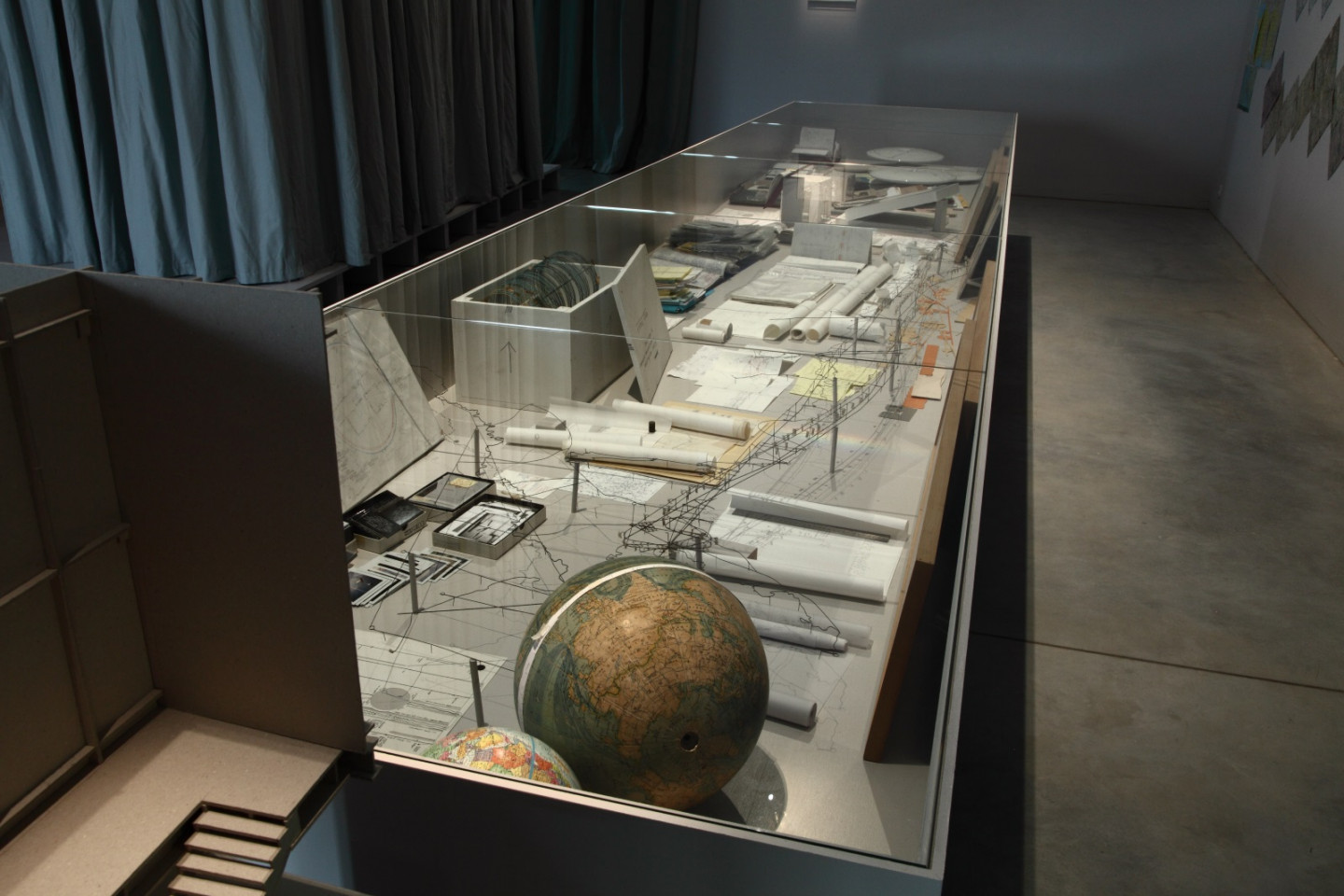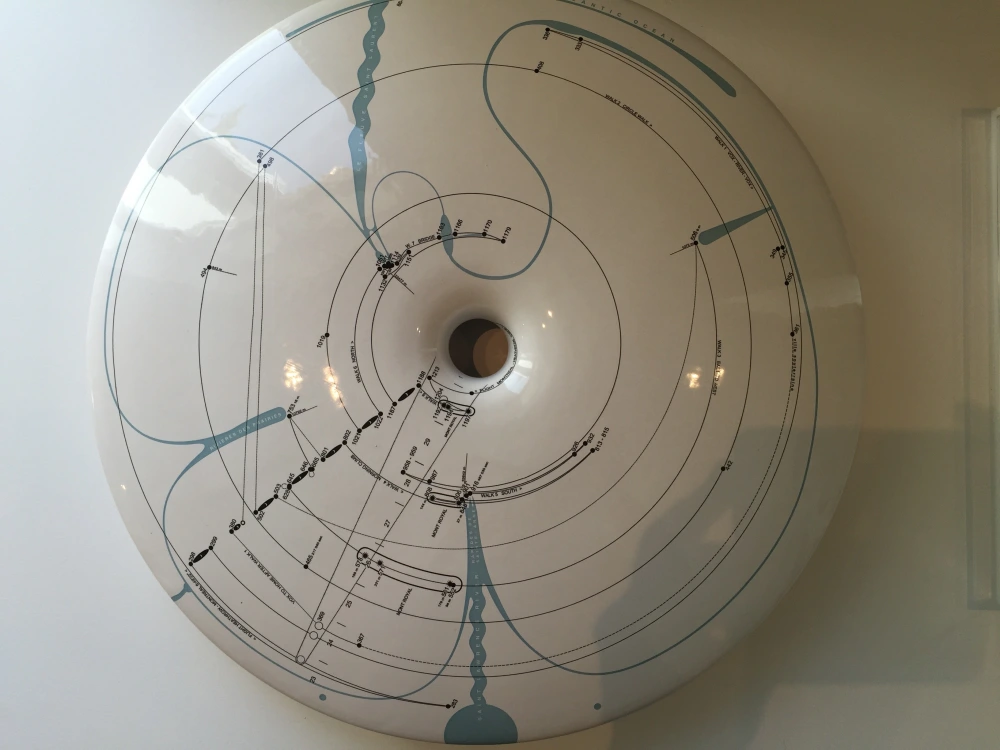Christoph Fink has a body of work entitled 'Atlas of Movements'. It is centred on how our bodies interact with our surroundings, and how we map out the interactions we have with the environments we pass though, as both cartographic and acoustic constructions. These 'mappings' consist of drawings, diagrams, tables and layers of sound, and they rely on the detailed annotations that Fink makes as he explores his situated-ness within the world.
Fink's notes
Fink has this to say about his work:
My notation method is a means of bringing a degree of structure or order from which to reflect further; or rather, it allows me to enrich the experience of time and space. .... my whole oeuvre is an archive, a sort of poetical databank. ...I picked out specific aspects of my work: my analogous visual archive (with some of my 85 000 slides), sources of inspiration, drawings I did as a child, a part of my video archive, sketches, marginal notes, etcetera. I show something of the origin of my work, my passion for space and time, for exploring in-depth our understanding of and views on landscape and man’s place in the scheme of things.
Christoph Fink: detail of a vitrine including notebooks and ceramic disks
Fink keeps precise records of his journeys (notes, photos, sound recordings, videos etc), which he works into drawings, timelines, graphs, sculptures, slideshows and soundscapes. He records the complex movements made by himself and how this passing through is entangled with the various situations he has to confront as he travels. He then gradually puts together objective recordings with subjective observations, so for instance, the timed patterns of movements of aircraft across the world may be made to intersect with historical facts about a city and much older facts about geological periods relating to the earth he is travelling over, all of which are then displayed in exhibitions and often as diagrams embedded into ceramic discs, that then sit alongside his other findings that will be recorded using more traditional formats. .
He states:
'From my first trip, I understood the importance of noting the coordinates of space and time. To literally inscribe oneself in space and time has great poetic potential for me. This is how I developed a method of working that is first and foremost “chrono-geographical.” It’s only later that I named and numbered each trip as a “movement.” Regardless of whether the journey is undertaken on foot, by bike, train or plane, the route is often a way to develop mathematical diagrams based on what I drew beforehand on the maps. I am fascinated by the way in which these diagrams are transformed or deformed by circumstances. For example, in Istanbul, I crossed the Bosporus diagonally and then crisscrossed the city, moving concentrically, walking through unplanned urban zones.....my primary interest is in the physical landscape (mountains, rivers, valleys, plains…) and how this shapes the city. I try to understand and sense why a city is in a precise place, where the tension points are, how people think and how things are done. To sum up, what interests me is something I could call the city’s rhythm'.
Fink believes that cartography is a widely underestimated form of conceptual art. My interest in his work is though centred on his work in ceramics; the three dimensional forms that carry his stripped down diagrams have a format that sits between sculpture and drawing. These forms allow him to produce hand held objects with drawings on them that as you move them around operate like complex compasses that can be used to orientate the person holding the piece. As you rotate them you read them in relation to where you believe you are. Then there is a second stage of engagement, that with the diagrammatic drawings made over the surfaces of these cast ceramic objects and your attempts to read them. Their combination of spatial and sound notation, intimated a process of engagement that I immediately thought of as if I was trying to read a type of alethiometer, the compass-like device that was used to communicate with a higher reality in Philip Pullman's 'His Dark Materials' books.
Fink developed three dimensional representations of the Earth's space-time as reflections of his awareness of the Earth as a rotating globe within a gravitational space time curvature. (See Faraday's lines of force post to get an idea of this)
Christoph Fink, The Montreal Walks (12 254,94 km, 195 h 30’51"),space and time disc, 2008. Ceramics, diameter 47cm.
His circular diagrams have a central void that embodies the hollow space that emerges alongside continuously emerging space-time, as in the diagram above. These ceramic objects involve detailed calculations, and are engraved with what he calls ‘moments of knowledge’. The complex information he details in his notes are reduced to very minimal linear forms and Fink's experience of the world is reduced to a map, rather like those we see on the weather forecast. In a form similar to the European weather map below, Fink's personal experiences of the physical reality of the world can sometimes be reduced to a few isobars.
European weather map
Fink as an artist gets a lot of residencies, which is very understandable as he brings an intensely focused way of researching a place or situation to a residency, and the organisers know that his work will produce both an aesthetically interesting series of objects and a way of getting audiences to look again at a place they have perhaps always thought of as something familiar.
Like all maps that a traveller carries on a journey, they mediate between the real world and the person travelling through it, but they not only suggest that we are passing through a physical three dimensional landscape, but that as we do certain sounds are heard and composed by the brain into a soundtrack for the landscape we traverse. These objects are for myself as an artist further examples of externalised thoughts, physical manifestations of imagined ideas and as such they are affirmations of the unique nature of the art object as something that sits balanced on a knife edge between materiality and intellectual concept.
See also:
See also:







No comments:
Post a Comment